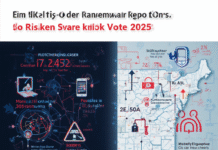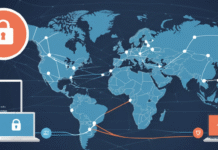
In today’s rapidly evolving cybersecurity landscape, remote ransomware has emerged as a formidable threat to organizations of all sizes and across various industries. Remote ransomware is a type of malicious software that encrypts a victim’s data, rendering it inaccessible until a ransom is paid. Unlike traditional ransomware, remote ransomware can be deployed from distant locations, making it more challenging to trace and mitigate. This method allows cybercriminals to target and exploit vulnerabilities in remote work environments, which have become more prevalent due to the global shift towards remote and hybrid work models.
According to the Allianz Risk Barometer 2024, ransomware remains one of the top concerns for businesses worldwide. The report highlights a significant increase in ransomware incidents, with attacks becoming more sophisticated and damaging. This trend underscores the urgent need for organizations to bolster their cybersecurity measures and stay ahead of potential threats. The shift to remote work has expanded the attack surface, providing cybercriminals with more opportunities to infiltrate networks through less secure home office setups, compromised personal devices, and unpatched software vulnerabilities.
No company is immune to the threat of remote ransomware. Small businesses, often lacking robust cybersecurity infrastructure, are particularly vulnerable. However, even large enterprises with comprehensive security protocols are not exempt from these attacks. The financial and operational repercussions of a ransomware attack can be devastating, including data loss, business interruption, reputational damage, and hefty ransom payments.
Understanding the mechanics of remote ransomware and its growing prevalence is the first step in developing effective protection strategies. Organizations must recognize the seriousness of the threat and implement proactive measures to safeguard their digital assets. By staying informed about the latest trends and threats in cybersecurity, businesses can better prepare for and mitigate the risks associated with remote ransomware attacks.
The threat of remote ransomware attacks has escalated significantly over recent years, posing a critical challenge for organizations worldwide. According to recent reports, there was a 150% increase in ransomware attacks in 2022 compared to the previous year, with remote workers often being the primary targets. This surge can be attributed to the widespread adoption of remote work, which has expanded the attack surface for cybercriminals.
Attackers have become remarkably sophisticated, utilizing advanced techniques to infiltrate corporate networks through inadequately protected remote devices. For instance, the infamous attack on Colonial Pipeline in 2021, which resulted in a multi-million dollar ransom payment, showcased how vulnerable critical infrastructure can be when remote systems are compromised. Similarly, the Kaseya VSA attack exploited vulnerabilities in remote management software, impacting thousands of businesses globally.
Statistical data underscores the growing menace. A study by Cybersecurity Ventures predicts that ransomware damages will cost the world over $20 billion in 2023, a stark rise from $11.5 billion in 2019. This alarming trend highlights the necessity for organizations to bolster their defenses against remote ransomware threats.
Remote ransomware attackers typically gain access by exploiting weak passwords, unpatched software, and unsecured remote desktop protocols (RDP). Once they breach a system, they deploy malicious software to encrypt files and demand ransom payments in cryptocurrency, making the transactions difficult to trace. The initial access is often facilitated through phishing emails, malicious attachments, or compromised remote access tools.
The increasing prevalence of remote work has also led to a rise in shadow IT, where employees use unauthorized devices and applications without the knowledge of IT departments. This practice further exacerbates the risk, as these devices may not have the necessary security measures in place to fend off sophisticated ransomware attacks.
In summary, the growing threat of remote ransomware attacks necessitates a proactive approach to cybersecurity. Organizations must prioritize securing remote endpoints, implementing robust password policies, and ensuring that all software is up-to-date and patched against known vulnerabilities. By understanding the evolving tactics of cybercriminals and fortifying defenses accordingly, companies can better protect themselves against the devastating impact of ransomware.
Mechanisms of Remote Ransomware
Remote ransomware operates through a series of sophisticated tactics that exploit vulnerabilities in remote devices and networks. Attackers typically begin by identifying insecure remote access points, such as weak VPN configurations, unpatched software, or poorly secured Remote Desktop Protocol (RDP) ports. Once a vulnerability is located, attackers employ various methods, including phishing emails, malicious attachments, or drive-by downloads, to gain initial access to the network.
After breaching the network, remote ransomware often leverages advanced techniques to escalate privileges and move laterally across the system. This lateral movement is facilitated by exploiting additional vulnerabilities in network protocols or by using stolen credentials to access other devices. The ransomware then systematically encrypts critical files, databases, and backups, effectively locking users out of their own data.
One of the key reasons traditional endpoint security solutions struggle to detect and prevent remote ransomware is the advanced evasion techniques used by attackers. Ransomware can disguise itself as legitimate software, employ polymorphic code that changes with each infection, or use fileless attacks that reside in the system’s memory rather than on the hard drive. These methods allow ransomware to bypass conventional signature-based detection mechanisms.
Furthermore, remote ransomware can be particularly challenging to combat due to its ability to communicate with command-and-control (C2) servers. These C2 servers enable attackers to remotely manage the ransomware, deploy updates, and exfiltrate sensitive data before encryption. This level of control makes it difficult for standard endpoint security tools to intercept and neutralize the threat in real-time.
In essence, the mechanisms of remote ransomware are designed to exploit the weakest links in network security, utilizing sophisticated techniques to infiltrate, spread, and execute their malicious payloads. Understanding these mechanisms is crucial for developing more effective protection strategies that go beyond traditional endpoint security measures.
Impact of Remote Ransomware on Businesses
Remote ransomware attacks pose a significant threat to businesses of all sizes, resulting in both immediate and long-term consequences. One of the most direct impacts is the encryption of critical business data. When attackers gain access to a company’s system, they encrypt essential files, making them inaccessible until a ransom is paid. This can bring business operations to a halt, leading to substantial financial losses. The cost of the ransom itself can be exorbitant, but additional financial burdens arise from downtime, lost productivity, and potential legal fees.
Beyond the immediate financial repercussions, businesses also face severe reputational damage. Customers and partners may lose trust in a company’s ability to protect sensitive information, leading to a loss of clients and future business opportunities. The public perception of a company’s reliability and security can take years to rebuild following a ransomware attack.
Operational disruptions are another critical impact. When systems are compromised, day-to-day operations can come to a standstill. This disruption not only affects internal processes but can also hinder customer service and supply chain operations. In industries where timely delivery and service are critical, such as healthcare or logistics, the operational impact can be particularly devastating.
In the long term, the damage from a remote ransomware attack can be existential. Small and medium-sized businesses may struggle to recover from the financial strain and reputational damage, leading some to close their doors permanently. Even larger enterprises are not immune to the existential threat; the cost of recovery can be so substantial that it affects their market position and long-term viability.
Real-world examples illustrate the grave impact of remote ransomware. The 2017 WannaCry attack affected over 200,000 computers across 150 countries, disrupting operations for major entities like the UK’s National Health Service. Similarly, the 2020 attack on Garmin, a global technology company, resulted in a multi-day shutdown of services, highlighting the far-reaching consequences of such incidents.
In conclusion, the impact of remote ransomware on businesses is multifaceted and far-reaching, affecting financial stability, operational continuity, and long-term viability. Addressing these challenges requires a comprehensive approach to cybersecurity and robust incident response planning.
Case Studies: Notable Remote Ransomware Incidents
Remote ransomware attacks have become increasingly prevalent, affecting organizations across various sectors. By examining notable incidents, we can gain valuable insights into the methodologies employed by attackers, the vulnerabilities they exploited, and the response measures that were taken. Such analysis is crucial for understanding the evolving threat landscape and strengthening cybersecurity measures.
One significant case is the attack on Colonial Pipeline in May 2021. The ransomware group DarkSide infiltrated Colonial Pipeline’s IT network, causing a temporary shutdown of its operations. The attackers exploited a compromised password that granted them remote access to the network. Colonial Pipeline’s response involved paying a ransom of $4.4 million, although a portion was later recovered through coordinated efforts with law enforcement. This incident highlighted the critical need for robust password management and multifactor authentication to secure remote access points.
Another notable incident is the Kaseya VSA ransomware attack in July 2021. The REvil ransomware group targeted Kaseya’s Virtual System Administrator (VSA) software, compromising its supply chain and impacting over 1,000 businesses worldwide. The attackers exploited zero-day vulnerabilities in the VSA software, allowing them to deploy ransomware on managed service providers’ clients. Kaseya’s swift response included shutting down their cloud servers and releasing a critical patch to mitigate the vulnerabilities. The incident underscored the importance of rigorous software vulnerability management and timely patch deployment.
The WannaCry ransomware attack in May 2017 also serves as a critical example. Utilizing the EternalBlue exploit, attackers leveraged a vulnerability in the Windows SMB protocol to propagate the ransomware globally. The attack affected over 200,000 computers across 150 countries, disrupting various sectors, including healthcare and transportation. The incident stressed the necessity of regular software updates and the implementation of network segmentation to limit the spread of malware.
These case studies illustrate the diverse tactics employed in remote ransomware attacks. They emphasize the importance of proactive cybersecurity measures, including robust password policies, multifactor authentication, timely patch management, and network segmentation. By learning from these incidents, organizations can better prepare for and defend against future ransomware threats.
Challenges in Defending Against Remote Ransomware
The surge in remote ransomware attacks has presented significant challenges for businesses striving to protect their digital assets. One of the primary hurdles is the inherent limitations of traditional endpoint security. Conventional security measures often fail to keep pace with the evolving tactics of cybercriminals, leaving systems vulnerable to sophisticated ransomware threats. Legacy antivirus solutions, for instance, are frequently outmatched by advanced malware that employs encryption and obfuscation techniques to evade detection.
Adding to the complexity, the remote working environment amplifies these vulnerabilities. With employees accessing corporate networks from various locations and devices, the attack surface expands exponentially. This decentralized structure makes it difficult for IT teams to maintain consistent security protocols across all endpoints. Many remote setups lack robust security controls, such as updated firewalls and intrusion detection systems, making them prime targets for ransomware attacks.
Detecting and responding to these sophisticated attacks poses another significant challenge. Cybercriminals continuously refine their methods, leveraging zero-day exploits and social engineering tactics to bypass security defenses. The use of multi-stage attacks, where an initial breach lays the groundwork for a subsequent ransomware payload, further complicates detection efforts. Additionally, the reliance on encrypted communications and anonymized payment methods makes tracing the origins of an attack and prosecuting perpetrators exceedingly difficult.
The evolving tactics of cybercriminals demand a dynamic and proactive approach to cybersecurity. They employ phishing schemes, exploit remote desktop protocol (RDP) vulnerabilities, and use automated tools to scan for weaknesses in network defenses. The increasing use of ransomware-as-a-service (RaaS) platforms also democratizes access to sophisticated attack tools, enabling even low-skill attackers to launch effective campaigns. This constant evolution requires businesses to stay ahead by continually updating their security measures and adopting advanced threat detection technologies.
In conclusion, defending against remote ransomware is a multifaceted challenge that requires a comprehensive and adaptive security strategy. Businesses must acknowledge the limitations of traditional endpoint security, address the complexities of remote work environments, and stay vigilant against the ever-evolving tactics of cybercriminals. Only through a concerted and informed effort can they hope to mitigate the risks and protect their critical data from ransomware threats.
Practical Recommendations for Effective Protection
Protecting against remote ransomware requires a multifaceted approach, combining technological advancements with proactive strategies and continuous education. One of the primary steps in fortifying defenses is strengthening endpoint security. Ensuring that all devices connected to the network have the latest security updates and patches is crucial. Utilizing endpoint detection and response (EDR) solutions can offer real-time monitoring and threat detection, providing an additional layer of security.
Implementing advanced threat detection solutions is another critical measure. These solutions leverage artificial intelligence and machine learning to identify and mitigate threats before they can infiltrate the network. Solutions such as intrusion detection systems (IDS) and intrusion prevention systems (IPS) can detect unusual activity and block malicious traffic, reducing the risk of ransomware attacks.
Regular security audits are essential to maintaining a robust security posture. Conducting these audits helps identify vulnerabilities and areas that require improvement. Organizations should perform both internal and external audits to ensure comprehensive coverage. Penetration testing, a proactive technique where simulated attacks are conducted to identify weaknesses, can also be beneficial.
Employee education plays a pivotal role in combating remote ransomware. Employees should be regularly trained on recognizing phishing attempts and social engineering tactics. Awareness programs can significantly reduce the likelihood of human error, which is often exploited by cybercriminals. Simulated phishing campaigns can be an effective way to measure employee awareness and response.
Developing a robust incident response plan is indispensable in the event of a ransomware attack. This plan should outline the steps to be taken immediately following an incident, including isolating affected systems, notifying relevant stakeholders, and engaging with cybersecurity experts. Regular drills and updates to the incident response plan ensure that the organization is prepared to act swiftly and effectively.
By integrating these practical recommendations, organizations can significantly enhance their resilience against remote ransomware threats. Continuous vigilance, combined with advanced technological solutions and employee awareness, forms the cornerstone of effective ransomware protection.




